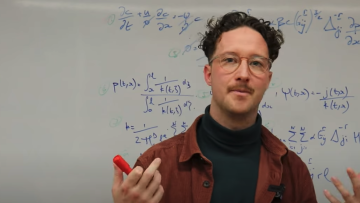16:00
New Lower Bounds For Cap Sets
Abstract
A cap set is a subset of $\mathbb{F}_3^n$ with no solutions to $x + y + z = 0$ other than when $x = y = z$, or equivalently no non-trivial $3$-term arithmetic progressions. The cap set problem asks how large a cap set can be, and is an important problem in additive combinatorics and combinatorial number theory. In this talk, I will introduce the problem, give some background and motivation, and describe how I was able to provide the first progress in 20 years on the lower bound for the size of a maximal cap set. Building on a construction of Edel, we use improved computational methods and new theoretical ideas to show that, for large enough $n$, there is always a cap set in $\mathbb{F}_3^n$ of size at least $2.218^n$. I will then also discuss recent developments, including an extension of this result by Google DeepMind.
A (quasi)-polynomial Bogolyubov theorem for finite simple groups
Abstract
We show that there exists $C>1$, such that if $A$ is a subset of a non-alternating finite simple group $G$ of density $|A|/|G|= \alpha$, then $AA^{-1}AA^{-1}$ contains a subgroup of density at least $\alpha^{C}$. We will also give a corresponding (slightly weaker) statement for alternating groups.
To prove our results we introduce new hypercontractive inequalities for simple groups. These allow us to show that the (non-abelian) Fourier spectrum of indicators of 'global' sets are concentrated on the high-dimensional irreducible representations. Here globalness is a pseudorandomness notion reminiscent of the notion of spreadness.
The talk is based on joint works with David Ellis, Shai Evra, Guy Kindler, Nathan Lindzey, and Peter Keevash, and Dor Minzer. No prior knowledge of representation theory will be assumed.
Applied Topology TBC
The join button will be published 30 minutes before the seminar starts (login required).
Applied Topology TBC
The join button will be published 30 minutes before the seminar starts (login required).
Cohomology classes in the RNA transcriptome
The join button will be published 30 minutes before the seminar starts (login required).
Abstract
Single-cell sequencing data consists of a point cloud where the points are cells, with coordinates RNA expression levels in each gene. Since the tissue is destroyed by the sequencing procedure, the dynamics of gene expression must be inferred from the structure and geometry of the point cloud. In this talk, we will build a biological interpretation of the one-dimensional cohomology classes in hallmark gene subsets as models for transient biological processes. Such processes include the cell-cycle, but more generally model homeostatic negative feedback loops. Our procedure uses persistent cohomology to identify features, and integration of differential forms to estimate the cascade of genes associated with the underlying dynamics of gene expression.
This is joint work with Markus Youssef and Tâm Nguyen at EPFL.


